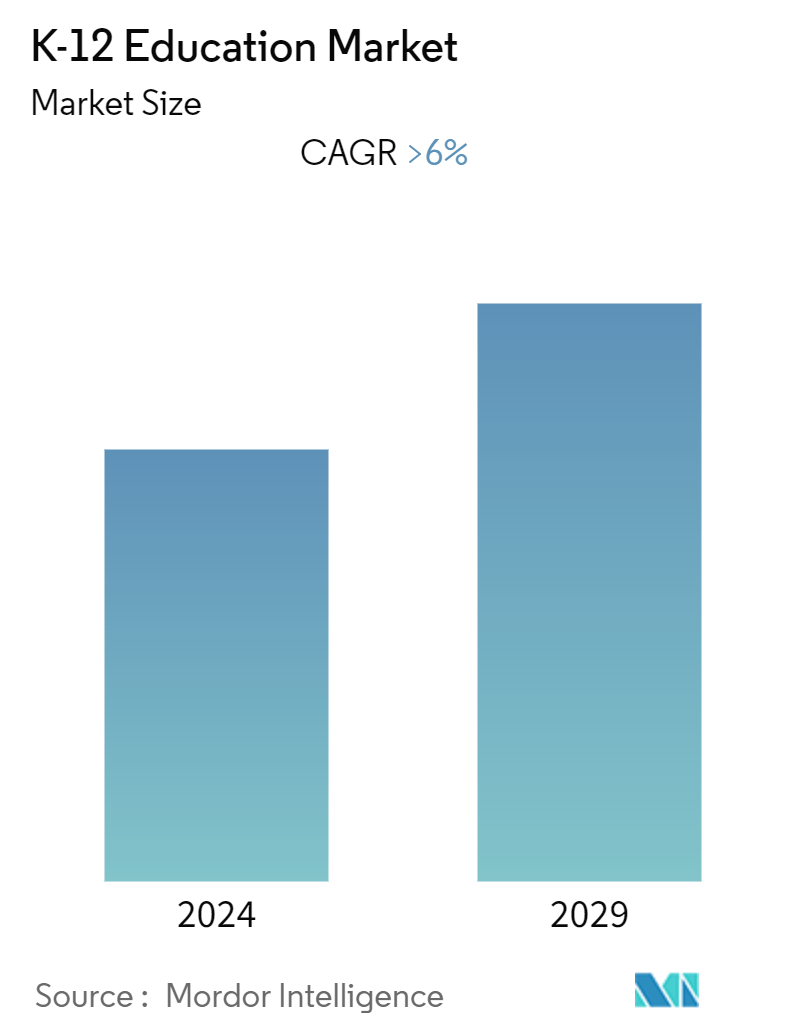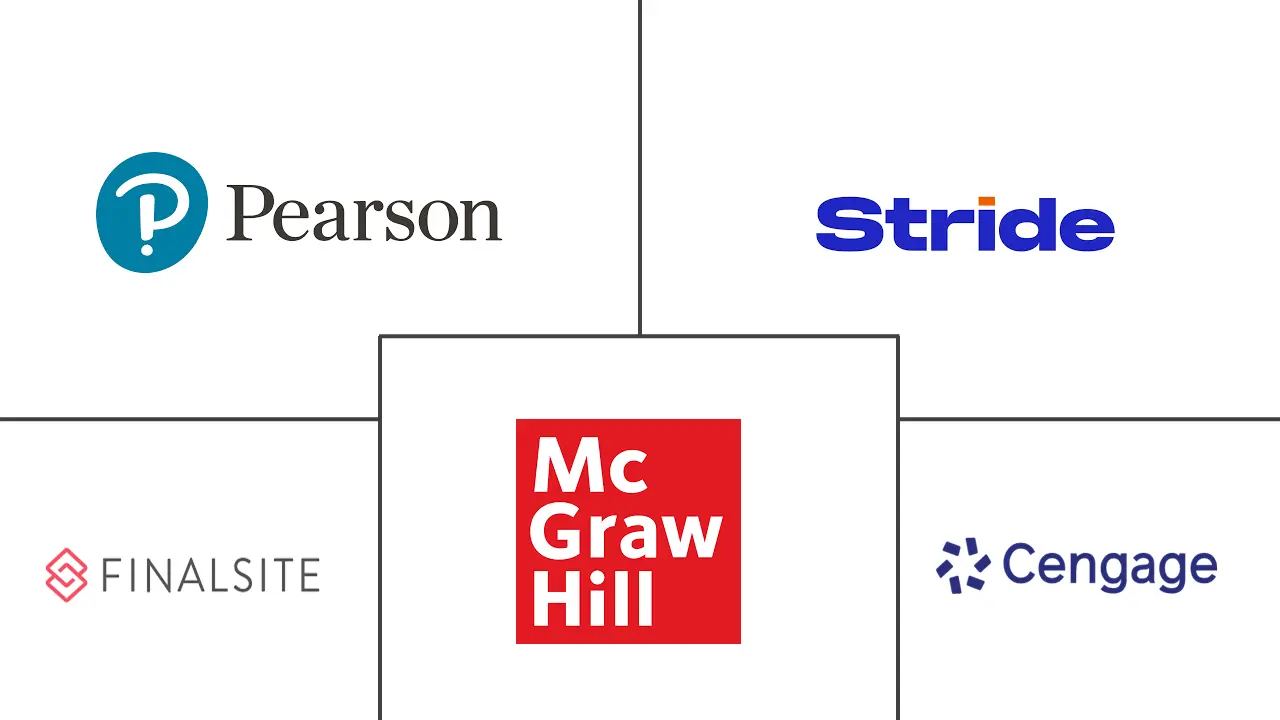Market Size of K-12 Education Industry

| Study Period | 2019 - 2029 |
| Base Year For Estimation | 2023 |
| CAGR (2024 - 2029) | > 6.00 % |
| Fastest Growing Market | Asia Pacific |
| Largest Market | Asia Pacific |
| Market Concentration | Low |
Major Players
*Disclaimer: Major Players sorted in no particular order |
K-12 Education Market Analysis
The K-12 Education Market is expected to register a CAGR of greater than 6% during the forecast period.
In recent years, the K-12 education market has witnessed robust growth, underscoring the rising significance of online learning in middle and high schools. The introduction of advanced online learning platforms and their growing adoption in public and private K-12 institutions has fueled this market expansion.
As technology permeates the education industry, schools and universities integrate innovative solutions. These include AR/VR interactive content, e-books, and online courses recognized by accredited universities. Consequently, the K-12 education technology market is poised for exponential growth. The increasing popularity of mobile devices for "smart learning" can be attributed to their portability and easy access to content and social interactions. Moreover, these devices facilitate swift communication between students and teachers, enabling efficient feedback collection. Recent advancements in ICT technologies allow for precise observation and measurement of learning outcomes, significantly strengthening market growth.
The advantages of online education largely drive the surge in digital learning solutions. These benefits include enhanced, video-based content that aids K-12 students' understanding. For example, in September 2023, Adobe, a leading American software firm, collaborated with India's Ministry of Education. This partnership will equip schools with an Adobe Express-based curriculum, training, and certification. Targeting 20 million students and 500,000 educators, the initiative underscores the growing embrace of software-driven education in K-12 institutions, with a goal set for 2027.
In K-12 education technology, the content type, user interface, and value proposition significantly change to cater to young learners. Companies must also prioritize the software's usability for teachers, parents, students, and school administrators. As K-12 students increasingly gravitate toward digital content, there is a notable rise in the adoption of e-books for online education. This shift allows educational institutions to present lessons more immersively and engagingly.
As children become accustomed to technology at younger ages, a swift move toward digitalization is tailored for this generation. Given their familiarity with platforms such as YouTube and mobile news articles, traditional classroom settings may need to be more engaging. Their changing habits of consuming information make learning through devices more attractive. Also, online education broadens horizons, enabling students to access international institutions without the need for relocation. This approach proves cost-effective, minimizing travel expenses and the need for physical textbooks.
However, challenges persist, particularly in developing economies where limited awareness of online learning is a brake on market growth. Many K-12 students still favor traditional learning methods, hindering the market's expansion. While the younger generation is adept with computers, true proficiency in online learning demands a deeper understanding of various software, presenting a notable challenge.
K-12 Education Industry Segmentation
K-12, a term used in education and educational technology in the United States, Canada, and some other countries, is a shortened form for the publicly supported school grades before college.
The K-12 education market is segmented by type (public K-12 education and private K-12 education), application (pre-primary school and primary school, middle school, and high school), and geography (North America, Europe, Asia-Pacific, Latin America, and Middle East and Africa). The market sizes and forecasts are provided in terms of value (in USD) for all the above segments.
| By Type | |
| Public K-12 Education | |
| Private K-12 Education |
| By Application | |
| Pre-primary School and Primary School | |
| Middle School | |
| High School |
| By Geography*** | |
| North America | |
| Europe | |
| Asia | |
| Australia and New Zealand | |
| Middle East and Africa | |
| Latin America |
K-12 Education Market Size Summary
The K-12 education market is experiencing significant growth, driven by the increasing adoption of digital learning platforms and services. This expansion is largely attributed to the rising popularity of online education, which offers benefits such as enhanced content delivery and flexible learning options. The integration of technology in education, exemplified by partnerships like Adobe's collaboration with India's Ministry of Education, underscores the global shift towards software tool-based education. Despite these advancements, challenges such as inadequate digital infrastructure and the digital divide in rural and developing regions pose obstacles to market growth. However, the widespread adoption of learning management systems and government initiatives to support digitalization in public schools are expected to bolster the market further.
In the Asia-Pacific region, the demand for K-12 education is rapidly increasing due to demographic and economic factors, technological advancements, and a focus on globalization. Countries in this region are increasingly integrating educational technologies, with online platforms and digital tools becoming essential components of modern education. The pursuit of high-quality education, coupled with government initiatives and a growing interest in providing a global perspective, is driving this demand. The market is characterized by fragmentation, with numerous companies competing for market share, including major players like McGraw-Hill Education and Pearson Education Inc. These developments highlight the dynamic nature of the K-12 education market and its potential for continued growth.
K-12 Education Market Size - Table of Contents
-
1. MARKET INSIGHTS
-
1.1 Market Overview
-
1.2 Industry Attractiveness - Porter's Five Forces Analysis
-
1.2.1 Bargaining Power of Suppliers
-
1.2.2 Bargaining Power of Buyers
-
1.2.3 Threat of New Entrants
-
1.2.4 Threat of Substitutes
-
1.2.5 Intensity of Competitive Rivalry
-
-
1.3 Impact of COVID-19 on the Market
-
-
2. MARKET SEGMENTATION
-
2.1 By Type
-
2.1.1 Public K-12 Education
-
2.1.2 Private K-12 Education
-
-
2.2 By Application
-
2.2.1 Pre-primary School and Primary School
-
2.2.2 Middle School
-
2.2.3 High School
-
-
2.3 By Geography***
-
2.3.1 North America
-
2.3.2 Europe
-
2.3.3 Asia
-
2.3.4 Australia and New Zealand
-
2.3.5 Middle East and Africa
-
2.3.6 Latin America
-
-
K-12 Education Market Size FAQs
What is the current K-12 Education Market size?
The K-12 Education Market is projected to register a CAGR of greater than 6% during the forecast period (2024-2029)
Who are the key players in K-12 Education Market?
McGraw-Hill Education (Platinum Equity), Pearson Education Inc., Cengage Learning India Pvt. Ltd, Stride Inc. (K12 Inc.) and Finalsite are the major companies operating in the K-12 Education Market.

